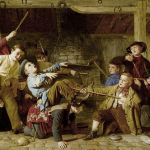 Music
Music  Music
Music  History
History 10 Less Than Jolly Events That Occurred on December 25
 Weird Stuff
Weird Stuff 10 Funny Ways That Researchers Overthink Christmas
 Politics
Politics 10 Political Scandals That Sent Crowds Into the Streets
 Weird Stuff
Weird Stuff Ten Bizarre Facts About The Doge Meme
 Our World
Our World 10 Ways Your Christmas Tree Is More Lit Than You Think
 Movies and TV
Movies and TV The 10 Coolest Stars to Set Sail on The Love Boat
 History
History 10 Things You Didn’t Know About the American National Anthem
 Technology
Technology Top 10 Everyday Tech Buzzwords That Hide a Darker Past
 Humans
Humans 10 Everyday Human Behaviors That Are Actually Survival Instincts
 Music
Music 10 Surprising Origin Stories of Your Favorite Holiday Songs
 History
History 10 Less Than Jolly Events That Occurred on December 25
 Weird Stuff
Weird Stuff 10 Funny Ways That Researchers Overthink Christmas
Who's Behind Listverse?

Jamie Frater
Head Editor
Jamie founded Listverse due to an insatiable desire to share fascinating, obscure, and bizarre facts. He has been a guest speaker on numerous national radio and television stations and is a five time published author.
More About Us Politics
Politics 10 Political Scandals That Sent Crowds Into the Streets
 Weird Stuff
Weird Stuff Ten Bizarre Facts About The Doge Meme
 Our World
Our World 10 Ways Your Christmas Tree Is More Lit Than You Think
 Movies and TV
Movies and TV The 10 Coolest Stars to Set Sail on The Love Boat
 History
History 10 Things You Didn’t Know About the American National Anthem
 Technology
Technology Top 10 Everyday Tech Buzzwords That Hide a Darker Past
 Humans
Humans 10 Everyday Human Behaviors That Are Actually Survival Instincts
Ten Horror Games That Were Banned for Being Too Dark
Horror games are no stranger to controversy, but these ten games took it a little too far, each crossing boundaries that got them banned or pulled from shelves around the world. From dystopian drug-induced joy to psychologically twisted survival games, these entries aren’t just scary to play—people were scared of what they could do.
Whether it’s Hotel 626’s eerie phone calls in the dead of night or Manhunt’s brutal, unapologetic violence, each game serves as a dark reminder of how far games and the gamers behind them can go.
Related: 10 Bizarre Urban Legends That Are Related to Video Games
10 Hotel 626
Let’s start with Hotel 626, the absolutely legendary web-based game that disappeared from the internet. Hotel 626 was released on October 31st, 2008, by none other than the company we all know and love, Doritos. Yes, I said Doritos. And yes, it is a horror game.
They wanted to revive their two dead flavors: Black Pepper Jack and Jack and Smokin’ Cheddar BBQ. Unfortunately, this was not a game about Cheddar Cheetah hunting you down and trying to kill you for eating his Cheetos. Instead, it was about waking up in a hotel that you found out pretty quickly that you didn’t want to stay at. You could only actually play it between 6 p.m. and 6 a.m. (though I’ve heard the stories of people changing the time on their clocks to play it), ensuring you had the perfect eerie backdrop of darkness when you played.
The game had a creepy, unique style that used videos and photos of real people instead of 3D avatars. Your only mission was to escape while being hunted by ghosts, demonic infants, and a psychotic hotel maid. Easy, right? Well, it was apparently really hard due to the puzzles, specifically the one where you’re locked in with a starved-to-the-point-of-insanity man who will eventually escape and eat you alive.
However, the thing that actually killed the game itself was its collection of personal information. The game used things to send shivers down the players’ spines. It asked for your phone number at the beginning of the game in order to call you with a pre-recorded message during the allotted hours in the middle of the night that told you that you were still in the hotel, which is absolutely… great, yeah.
The second is used within the game. There was one particular part where you had to run away from a chainsaw-wielding maniac by finding a photograph that showed your own face from your webcam (or the hotel lobby if your webcam was off). However, as you were looking for your own face, you saw tens of other faces in your desperate escape. These faces were not actors but pictures taken of people in their own bedrooms reacting to the chainsaw maniac following them. Now, the only problem is that Doritos never asked the player for permission to use their webcam and pictures. Yikes.
This led to a panic from the legal department side of Doritos, and critics and privacy advocates pointed out the potential risks of hackers. Doritos eventually pulled the website from the internet to avoid being sued. Thus, they weren’t actually banned, but most likely were going to be, and they pulled the plug on themselves.[1]
9 We Happy Few
We Happy Few transports players to an alternate 1960s England, a place where the streets are tidy, the colors bright, and everyone is, without exception, blissfully cheerful—or so it seems. The only thing that seems to keep the place running is “Joy,” a happiness pill designed to keep citizens smiling while erasing any uncomfortable memories of the past and everything that makes you you. Those who decide to stop taking Joy are labeled “Downers,” outcasts who are hunted down by the smiling authorities for “rehabilitation.” The game’s take on happiness, controlled by the iron fist of a drugged-up dystopia, poses an uncomfortable question: What’s the price of happiness if it’s manufactured? Turns out, it’s not pretty.
The story begins with Arthur Hastings, one of three characters you can control throughout the game. He discovers an old newspaper clipping that jogs his memory of events before Joy, spurring him to go off the drug and start seeing the crumbling reality around him. The town of Wellington Wells is bright on the surface, but for those not dosed up on Joy, the illusion fades quickly into a grim picture of societal and physical decay. Citizens go about their days in a forced euphoria, with the Joy-enforcing “Bobbies” smiling widely while clubbing anyone who dares to so much as frown. As someone who just watched Smile 2, I have an all-too-good vision of what this would be like in real life, and I don’t like it.
However, We Happy Few was a bit too dark. The game faced a temporary ban in Australia, where authorities claimed that its depiction of Joy might encourage substance abuse, echoing real-life concerns about drug normalization. The controversy highlighted the game’s balance between satire and shock value, as critics argued that its portrayal of forced happiness struck too close to reality. Yet supporters countered that the game isn’t about glorifying drug use—it’s a cautionary tale about the dangers of a society that sacrifices authenticity for the sake of fake positivity.
The ban was eventually lifted, as predicted in 2019. Its portrayal of a world addicted to false happiness simply points to our current social pressures to “just be happy.” By forcing players to choose between following the crowd or holding onto reality, the game poses an unsettling thought: can happiness be real if we don’t have a choice? And maybe more hauntingly, are we already swallowing our own version of Joy?
You might be able to tell I love this game’s concept.[2]
8 Phantasmagoria
Imagine booting up your computer and stepping into the surreal, eerie world of Phantasmagoria. The game was definitely intended to keep you awake for hours after playing—or falling asleep to nightmares. Set in a massive, creaking mansion on a fog-draped coast, the game drops you into the life of Adrienne Delaney, a writer hoping to escape distractions with her husband in tow. As the days wear on, it turns out this mansion has more inspiration than she bargained for.
Slowly, Adrienne uncovers the twisted history of its former owner, a magician who dabbled in dark arts that left a lasting impression—and maybe a few curses behind. So much for inspiration, right? One of the game’s groundbreaking features was its usage of full-motion video (FMV), meaning real actors were filmed to play each character, adding a bit of raw realism that made each horrifying scene even more terrifying. Yay!
As Adrienne’s husband descends under the mansion’s spell, he transforms from her loving husband into a twisted and maniacal stranger. Love does drive you crazy, after all. The use of live actors brought an unsettling authenticity that caused horror fans to flock to the game in droves. With each sequence more gruesome than the last, the line between virtual horror and real-life terror became disturbingly thin. This live footage is also what paved the way for Hotel 626 just a decade later, and it’s what I have to personally thank for making horror games better.
When Phantasmagoria was released in 1995, it was met with a mix of fascination and outrage. Its unfiltered scenes of violence, supernatural possession, and psychological abuse quickly earned it a reputation as one of the most controversial games of its time. Critics were quick to condemn it as “too explicit,” arguing that some scenes were simply beyond the boundaries of good taste.
The now-infamous “head-in-the-blender” moment alone redefined how far horror could go in gaming, with fans eagerly replaying scenes while some critics wondered if they’d accidentally wandered into a horror film set. Australia, once again, was less enthusiastic, banning the game outright for being “too dark.”
Apparently, they didn’t care much for the murder, possession, or the infamous “head-in-the-blender” moment, a scene that truly redefines “blending genres.” But despite the ban, or maybe because of it, Phantasmagoria endures as a darkly beloved cult classic, known for taking horror out of the shadows and into a player’s lap—often a bit more literally than anyone expected.[3]
7 Rule of Rose
Beneath the facade of its orphanage setting, Rule of Rose is anything but kid-friendly. Jennifer, the game’s protagonist, quickly learns that she’s the latest “lucky” entrant into the twisted social structure run by a gang of children who call themselves the Red Crayon Aristocrats. But this isn’t playtime with jump ropes and hopscotch. Unless you’re okay with the squares being replaced by symbols of ritual sacrifice. The “games” involve strange sacrifices and crazy rituals that make Jennifer the unwilling star player. Eventually, you’ll question if you liked the kids in Lord of the Flies better.
Rule of Rose achieves its horror by leaving most of the terror to the imagination and by hinting at everything behind the scenes. It leads to the feeling of cult-like control and a social hierarchy gone awry. While other games might use zombies or monsters, here, it’s the children themselves who set the stage for horror, forcing Jennifer into disturbing tasks involving cages, mutilated dolls, and animal sacrifices.
Each ritual drags her deeper into their twisted little “games.” As she endures ritual after ritual, she slowly uncovers twisted truths about the children, each task dredging up memories from her own traumatic past. It’s dark psychological horror at its finest—or worst, depending on how you feel about repressed memories resurfacing in the form of creepy lullabies. While this game was definitely more so on the violent side than the sexual side, some journalists claimed that the game had violent erotic undertones with underage girls. This, of course, caused the critics to make an even bigger uproar about the game, even getting the mayor of Rome and the EU involved in its release.
But it was Italy this time, not Australia, that took the largest issue with it. Italians bantered about banning it, saying that “Every frame is dripping with perversion.” Politicians in the UK fueled outrage over content they hadn’t even seen, based on rumors and worst-case guesses. It was eventually released anyway, but only in small amounts, making it a rare and expensive find today. The mix of eerie children, cult-like rituals, and symbolic violence even made sure it stayed off the shelves in several places.[4]
6 Manhunt
Manhunt is what happens when someone decides a horror game can never be too bleak or too brutal. You play as James Earl Cash, a death row inmate given a second chance—though “second chance” is a bit generous when you’re dropped into a live-action snuff film. Cash’s director and “savior” is a shadowy figure who’s orchestrating every bloody detail for his own twisted film. From the moment Cash steps out of that prison van, his only goal is to survive the night by creatively dispatching a series of gangs—groups like the Hoods and the Smileys, each a little more colorful than the last in their own murderous way.
The game’s “murder with style” approach quickly grabbed attention, with every kill graded on a scale from “quick and clean” to “horrifyingly elaborate.” Manhunt doesn’t just let you eliminate enemies; it challenges you to do it with… pizzazz. Weapons range from plastic bags to nail guns, each lending a different flavor to your executions. The Director encourages the most vicious kills, rewarding Cash with higher scores for each gruesome masterpiece as he sneaks, creeps, and bludgeons his way through each gang. Art school really has changed, eh?
It was immediately banned in New Zealand, labeled as “grossly offensive,” which is just another way of saying they’d prefer it never see daylight. Australia pulled its rating with lightning speed, and the UK took it off shelves briefly after a real-life murder was initially linked to the game—a claim that was later disproven. The game was so infamous that critics quickly raised questions about whether Manhunt was even a game or just an interactive horror film.[5]
5 Hatred
Hatred is, in a word, unapologetic. The main character (he has no name) wakes up, stares into the mirror, and, instead of making affirmations or grabbing a coffee, decides it’s time to kill everyone in sight. You play as “The Antagonist,” a nihilistic anti-hero clad in a leather trench coat who’s basically the twin of Bleach’s Yhwach. His whole mission? Complete destruction of anyone and everyone.
This game doesn’t mince words—or actions. In Hatred, there are no redemptive story arcs and no world-saving quests. The entire thing is a sandbox game where the goal is simply to be as destructive as possible. And while most games are like, “Hey, maybe save the city,” Hatred is more like, “Here’s your assault rifle, and maybe don’t forget the grenade launcher.” Each level is a parade of carnage as you roam a town that might as well have a banner reading “Welcome, We’re All Targets.” In-game scores even reward you for increasing mayhem, turning every quiet street into the world’s darkest block party.
The backlash? Immediate and intense. It was temporarily pulled from Steam Greenlight after complaints that the game “promotes wanton violence,” a charge that developers shrugged off with a “Yes, exactly.” And while Grand Theft Auto might get flak for “glamorizing crime,” Hatred threw its hands up and said, “Forget glamour, let’s just go all in.”
The developers state that the purpose of the game was to eliminate all the “fake philosophical stuff” thrown into games to justify their violence. The result? An unapologetic, chaotic game full of violence and animalistic nature. The game was banned in several countries, including Germany and New Zealand, and was widely labeled as irredeemably violent.[6]
4 Mariam
Originally developed in Saudi Arabia, Mariam caused a stir almost as soon as it hit the app store. The game follows a young girl named Mariam who’s “lost” and asks the player for help finding her way home. But what starts off as a seemingly innocent interaction turns creepy fast. While guiding Mariam, players are prompted with increasingly personal and invasive questions, starting by stating she can read your mind by talking about trending news stories and then ending with a casual “Where do you live?”.
The game escalates through these bizarre, unsettling questions that make you wonder if Mariam is more of a stalker than a lost child. As the game progresses, it becomes less about helping Mariam and more about surviving her situation, making players feel like they’re stepping into a horror-themed therapy session they never signed up for.
What really ramped up the unease was the game’s tendency to ask for players’ location access, sparking rumors about potential surveillance and data collection. Reports swirled that Mariam might actually be tracking players, with each spooky message hinting at a ghostly GPS service run by Big Brother. The game wasn’t actually gathering any data, but the game’s eerie atmosphere and unsettling questions led to privacy concerns among players and their parents. It wasn’t long before the app felt less like a game and more like an interactive urban legend, where players were helping a lost girl… and giving her far more information than anyone should share with a haunted app.
In Saudi Arabia, Mariam sparked controversy, with concerned parents accusing the game of influencing children in unhealthy ways. Some even claimed that it promoted self-harm, though no evidence surfaced to support these allegations. Given the outcry, authorities acted swiftly, banning the app and issuing warnings about its “psychological impact” on young players. Apparently, the horror game had done its job a little too well, blurring the line between suspenseful gameplay and digital intrusion.
Mariam remains a curiosity, with its unsettling gameplay and strange mechanics drawing to those with a taste for the mysterious. But it’s more than just a horror game—it’s a digital campfire story that dares you to play and then leaves you wondering if you should have. In the end, Mariam became as much an urban legend as it was an app, proving that sometimes the scariest thing of all is realizing you’ve willingly handed your location to a creepy, fictional child.[7]
3 Postal 2
Postal 2 is the video game equivalent of a fever dream had by someone who watched too many action movies on fast-forward. The game follows “The POSTAL Dude,” a guy who’s just trying to get through his week with simple errands like picking up milk, cashing a paycheck, and returning a library book. Sounds mundane, right? Wrong. Postal 2 gives you the option to complete each task peacefully or… not-so-peacefully. And by “not-so-peacefully,” we’re talking about flamethrowers, a shovel with a wickedly sharp edge, and a lot of chaos.
Set in a small desert town, Postal 2 doesn’t just allow for violence—it practically rolls out the red carpet for it. Almost every NPC has a quick insult ready if you look at them the wrong way, and the town is filled with groups like rampaging protestors and angry fundamentalists. If you thought going to the bank was stressful, Postal 2 makes it feel like a gladiator match. And just when you think it couldn’t get more absurd, the game hands you a health pack in the form of—you guessed it—catnip, which also doubles as a silencer if you attach a cat to the barrel of your rifle. Yes, Postal 2 is that kind of game.
Obviously, the response was explosive. Postal 2 was banned outright in New Zealand, where authorities labeled it “grossly offensive”—again! They really like that terminology, am I right? Australia followed suit, refusing it on the grounds of excessive violence and animal cruelty. Even in the U.S., it found itself in hot water, particularly within the court system, which pointed to it as proof that video games were steering the youth down a dark path. For once, the game’s creators didn’t argue, proudly marketing it as the game that will give the dark side of your imagination free reign.[8]
2 Demonophobia
This RPG-visual novel hybrid throws you into a nightmare designed to test your mental stamina (and maybe your sanity). You play as Sakuri Kunikai, a 14-year-old girl. Without a clue as to where she is, Sakuri quickly realizes she’s in a world where everything has just one goal: to make her time here as torturous as possible.
What sets Demonophobia apart is that it doesn’t let you just get through the horror; it demands you watch it unfold in painstaking, pixelated detail. As if the silent, soundtrack-free gameplay weren’t ominous enough, the game makes every mistake lead to a new, disturbing death scene. Each creature has its own gruesome “surprise” for Sakuri. These vary from decapitation to death by slime (which somehow manages to be even worse than it sounds).
The game’s design pushes you to experience each death scene with the kind of loving attention to detail that could only come from a developer with a deep appreciation for Ryona-style brutality and gore. You could say that Demonophobia doesn’t just want you to play it; it wants you to suffer along with it.
By the time you reach Stage 4, things really start to get… weird. Sakuri faces off against grotesque bosses like Asmodeus, and with every level, the game finds new ways to make the whole experience feel progressively twisted. Sakuri, who is still 14, by the way, can lose her clothes, get ambushed by slimy creatures, or face certain “fan-service” moments that are despicable and disgusting to watch. While the game was made in Japan with a lower age of consent, it unsurprisingly caused outrage outside of the country.
Many countries banned it outright, not just because of the VERY questionable erotic scenes with a minor, but also because of the gore and its unapologetic way it served up horrific scenes without any clear purpose beyond shock value. Critics questioned whether it was a game or just a collection of gruesome animations in disguise. Still, Demonophobia still has its loyal fans, mainly in Japan, who are drawn to its sadistic challenges and the dark thrill of surviving each level. For those who make it through, it’s less “I beat the game” and more “I survived it.”[9]
1 Euphoria
Euphoria, the darkest entry on our list, is an 18+ interactive visual novel game that walks a razor-thin line between psychological horror and boundary-pushing content. It leaves players to navigate an intensely disturbing plot that only gets darker the deeper they go. Set in an isolated, sterile white room, the game begins with protagonist Keisuke Takatou and six other women, five of his classmates, and one teacher, waking up in captivity with no memory of how they got there.
An anonymous speaker leaves them with a disturbing objective: only through a series of twisted and degrading “games” will they survive and escape. Each “game” unlocks a door, forcing players to decide how far Keisuke—and themselves—are willing to go to escape this nightmare. It’s a horror of the mind, with each task chipping away at the characters’ sanity and, frankly, the player’s as well.
Instead of jump scares, Euphoria focuses on psychological torment, making the characters’ physical and mental suffering disturbingly vivid. Keisuke is told to rape and sexually torment all the girls, most of who are also underage, I’d like to point out again, in the room in order to escape. Throughout the game, it becomes clear that each scenario is part of a larger mystery involving Keisuke’s own dark impulses as he constantly battles with his desire to go too far. The storyline gradually reveals more about each character’s background. The game does offer multiple endings, ranging from bleak to (relatively) redemptive, depending on the player’s choices.
While Euphoria is classified as a mature X-rated game, its usage of underaged girls, once again in Japan, makes the entire game even more unsettling and disturbing to play. Euphoria’s extreme content drew criticism for both its disturbing and erotic subject matter and its graphic depictions of violence. Many critics argue that the game crosses the line that no game should go. In reviews, some players admit that Euphoria is like watching a car crash: gruesome, horrifying, but hard to look away from.[10]








